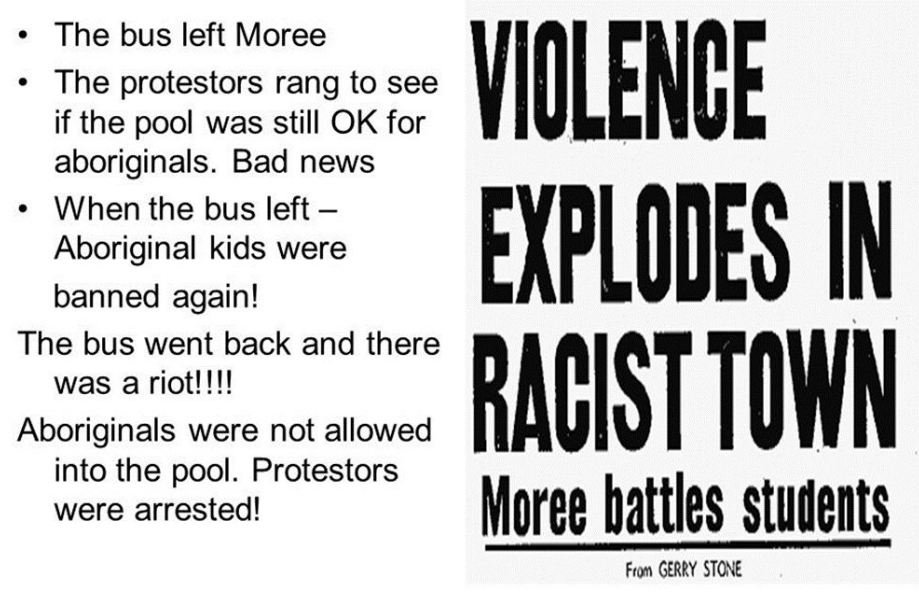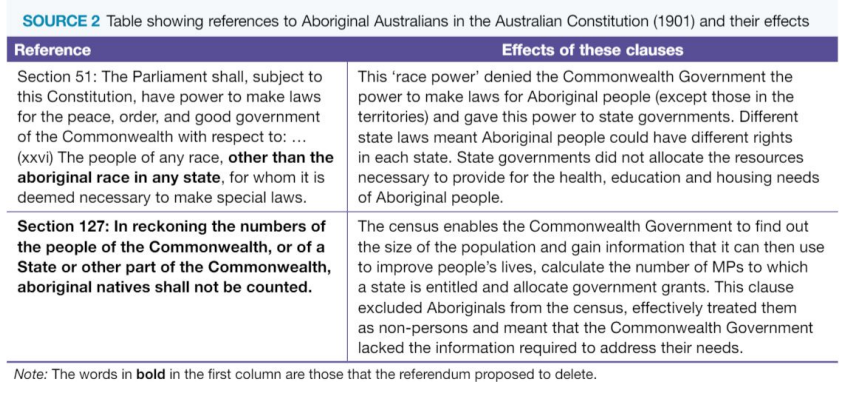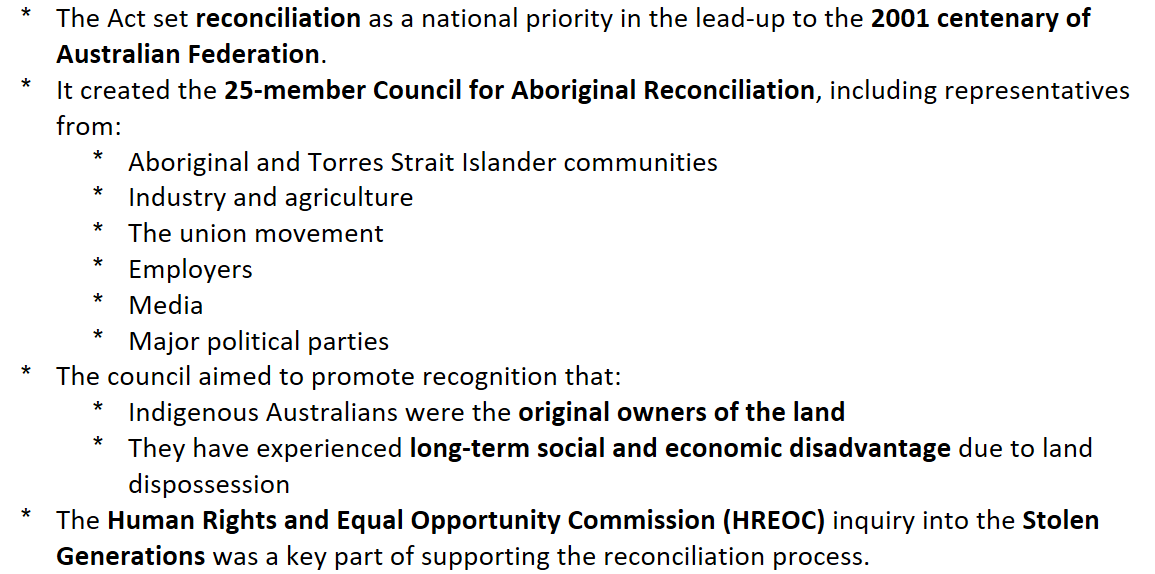Civil Rights and Indigenous Australians
1/75
Earn XP
Description and Tags
Flashcards about the Civil Rights Movement, Rosa Parks, Freedom Riders, Charles Perkins, the 1967 Referendum, Land Rights & Mabo, and Bringing them Home.
Name | Mastery | Learn | Test | Matching | Spaced |
|---|
No study sessions yet.
76 Terms
Civil Rights
Guarantees of equal social opportunities and equal protection under the law, regardless of race, religion, or other personal characteristics.
Segregation
The action or state of setting someone or something apart from others.
Rosa Parks
Known as 'the mother of the civil rights movement.' She sparked the fight for racial equality by refusing to give up her bus seat to a white man in Montgomery, Alabama.
Rosa Parks' Arrest
Led to the Montgomery Bus Boycott after Rosa Parks' arrest on December 1, 1955.
Freedom Riders
Challenged and tested the segregated interstate travel system by deliberately violating Jim Crow laws from May to November 1961.
Australia 1960s Civil Rights Context
Australian government supported US Civil Rights Movement yet did little to end racism in Australia during the 1960s.
Charles Perkins
Born in Alice Springs in 1936, served as vice-president of the Federal Council for the Advancement of Aborigines, and led the 1965 Freedom Ride of rural New South Wales.
1965 Freedom Ride Aim
Aimed to raise awareness about discrimination against Aboriginal people and address the issue through non-violent action.
Moree Discrimination
Resulted in a council by-law prohibiting Aboriginal people from using local baths and swimming pools in 1955.
Impact of Charles Perkins & the Freedom Ride
Brought national attention to the Freedom Ride, showcasing images of racist behaviour in country towns.
Charles Perkins' Leadership
Became a national figure and a role model for Aboriginal Australians, showcasing leadership skills through organizing protests and public debates.
1967 Referendum
Aimed to remove racial discrimination against Aboriginal people from the Australian Constitution.
Action for reform: 'Right wrongs, write yes'
Highlighted racial discrimination and emphasized injustices faced by Aboriginal Australians.
Pressure
Commonwealth Government to hold a referendum to remove discriminatory clauses from the Constitution.
Major campaign milestone
Faith Bandler and Jessie Street launched a petition at Sydney Town Hall aiming for 100,000 signatures — they collected one million.
The significance of the referendum
Showed the power of ordinary people to achieve change and marked the change from Indigenous Australians’ exclusion from to inclusion within the Constitution.
Land Rights & Mabo
Australia's east coast became Crown land, and officials justified this with saying Australia was terra nullius.
1966
Gurindji people walked away from their low wages and poor living conditions on the Northern Territory's Wave Hill cattle station.
1968
Yirrkala people began a case in the Northen Territory Supreme Court.
26th January 1972
Set up an Aboriginal embassy in a tent on the lawns in front of Parliament House in Canberra.
The Whitlam government
Enacted the Racial Discrimination Act (1975) and introduced a self-determination policy.
Eddie Koiki Mabo
Led a court case challenging the government’s right to do this.
3 June 1992
The High Court handed the decision in Mabo and Others v.
3 June 1992
The State of Queensland (1992), the case now known simply as Mabo
The Significance Of the Mabo Decision
It overturned the legal fiction that Australia had been terra nullius when the British took possession of it in 1788.
Native Title
Is the recognition of Indigenous people’s traditional rights to land from before 1788.
Land rights
Differ from native title rights in that land rights are linked to claims people make to governments to be recognised as the legal owners of a particular area.
Reconciliation
Set reconciliation as a national priority in the lead-up to the 2001 centenary of Australian Federation.
Bringing them Home
The Human Rights and Equal Opportunity Commission (HREOC) inquiry into the Stolen Generations was a key part of supporting the reconciliation process.
HREOC's
Launched a national inquiry into the forced removal of Aboriginal and Torres Strait Islander children from their families.
HREOC concluded
Forcibly removing Indigenous children breached Australia's commitment to the UN Convention on Genocide
Government responses
Pledged $63 million towards implementing HREOC’s suggestions
How many people were in the Montgomery bus boycott
17,000
Context of Australia 1960s
Australian government supported US Civil Rights Movement yet did little to end racism in Australia.
Australian Youth challenged traditional values of the previous generation and opposed government decisions.
Women demanded equal rights
Increase in racial equality

Charles Perkins
He was a talented soccer player and played professionally in England from 1957 to 1960.
Perkins served as vice-president of the Federal Council for the Advancement of Aborigines.
He relocated to Sydney in 1962.

What happened in 1963 (Charles Perkins)
he began studying at the University of Sydney and helped found Student Action for Aborigines (SAFA), eventually becoming its president.
Perkins aimed to challenge the criticism that Australians supported the US Civil Rights Movement but were slow to combat racism within Australia.

Freedom Ride in Australia
On 12 February 1965, he led about 28 others on a 14-day, 3200-kilometre Freedom Ride of rural New South Wales.

Which towns did the Australian Freedom Riders go in?
Focused on towns with a reputation for racism, such as Walgett, Moree, and Kempsey.
Also targeted towns like Lismore, which were thought to have better records on race relations.

What concerns did the Freedom Riders in Australia address?
Appalling living and health conditions
forced to live on reserves outside country towns
With local authorities denying Aboriginal people access to facilities (e.g. hotels, clubs, pools, services in ships, equal treatment in society)
Rural community discrimination

What happened in Walgett
Local RSL club refused ALL Aboriginal entry (other than occasional ANZAC Days).
Freedom Rides: Held up posters and addressed onlookers proclaiming ‘Aborigines also fought’, ‘Bullets did not discriminate’ and ‘Good enough for Tobruk, why not Walgett RSL?’.

What was the public’s reaction to Walgett?
They ended up being evicted from lodgings at local hall because many residents disliked their actions.
A convoy of cars and trucks trailed the bus as it left Walgett.
One of the trucks deliberately forced the bus off the road.
The incident reminded the students of the three American civil rights activists who had been beaten and shot on a rural road in Mississippi, just eight months prior
Incident was reported in The SMH, Daily Mirror, The Australian newspapers

What happened in Moore
In 1955, council by-law prohibited Aboriginal people (any) from using local baths and swimming pools.
The town also refused to allow Aboriginal patients to share hospital facilities with white patients and that Aboriginal people should be buried separate from white community.
SAFA's protest started with a demonstration outside the council building.
They then gained permission from families to take eight children and attempt to enter the pool.
Charles Perkins brought additional children from the reserve.
The pool manager refused to sell them entry tickets, stating, "darkies not allowed in."

Moore Riot

Raising public awareness
Perkins arranged television coverage of the Freedom Ride with the executive producer of Channel 7's Seven Days program.
The TV coverage, along with newspaper reports, brought national attention to the Freedom Ride.
It showcased images of racist behaviour in country towns, exposing these injustices to Australian viewers.
The Freedom Ride sparked widespread discussion and debate across Australia about the struggles of Indigenous communities.
Media coverage led to increased national and international pressure for reform.

Support for the 1967 referendum

The Freedom Ride helped attract media attention to the injustices faced by Aboriginal people, putting pressure on Australian governments and political parties to take action.
It became a key part of the campaign movement leading to the 1967 referendum.
The referendum aimed to remove racial discrimination against Aboriginal people from the Australian Constitution.
Growing public awareness of racial discrimination provided the necessary context for the success of the referendum.

Perkins' ongoing role

Perkins dedicated his life to campaigning for the recognition of Aboriginal rights.
In 1981, the Fraser government appointed him Secretary of the Department of Aboriginal Affairs, making him the first Aboriginal Australian to lead a federal government department.
He protested against authorities' reluctance to allow self-determination for Aboriginal people.
Perkins also criticized the government's failure to address inequalities in Aboriginal Australians' access to education, health, housing, employment, and the law.

A state funeral (Charles Perkins)
Charles Perkins passed away from kidney failure on 18 October 2000.
The federal government honoured him with a state funeral, a privilege typically reserved for those who have held significant government positions.
ABC television broadcast the funeral, and traffic on George Street in Sydney temporarily stopped.
A crowd gathered outside Sydney Town Hall to watch the funeral service on a large screen.

Australia votes- Civil Rights in Australia in the 1960s

On 27 May 1967, Australia held a significant national referendum.
The referendum focused on the status and rights of Indigenous Australians within society.

This high level of support was notable in a country often viewed internationally as racist.
It was also unusual in a nation where voters typically resisted major changes to the existing system.

How many people voted yes for the 1967 Referendum
It resulted in an overwhelming 90.77% of voters choosing ‘yes’.

Which 2 sections were removed from the constitution
127 and 51
What did each section state?

‘Right wrong, write yes’ campaign
From 1957, growing pressure was placed on the Commonwealth Government to hold a referendum to remove discriminatory clauses from the Constitution.
The campaign emphasized the injustices faced by Aboriginal Australians, including segregation, poor wages, racism, and limited opportunities.

Key groups and individuals in the ‘Right wrong, vote yes’ campaign
Federal Council for the Aboriginal Advancement (later Federal Council for the Advancement of Aborigines and Torres Strait Islanders FCAATSI).
Council for Aboriginal Reconciliation (CAR).
Indigenous rights activists Faith Bandler and Charles Dixon.
Jessie Street, a political and social reform activist.
Labor MP Gordon Bryant, a supporter of Aboriginal rights and leader in the Aboriginal Advancement League of Victoria

Major campaign milestone

On 29 April 1957, Faith Bandler and Jessie Street launched a petition at Sydney Town Hall aiming for 100,000 signatures — they collected one million.

‘Right wrong, vote yes’ strategies to raise awareness
Media coverage, especially of Charles Perkins’ 1965 Freedom Ride, which highlighted racial discrimination.
Discussions in school classrooms
University events featuring guest speakers.
Petitioning and lobbying politicians to present the petitions in federal parliament.
William Grayden’s 20-minute film on the Warburton Ranges crisis, which showed the suffering of displaced Pitjantjatjara people due to nuclear testing.
The film revealed severe issues including drought, malnutrition, and lack of healthcare.
Grayden, Western Australia’s Minister for Native Welfare, aimed to expose these harsh realities.

What was the result of the Referendum
While the referendum result had great symbolic importance, it had little practical benefit for Aboriginal people as:
Inequities continued in pay and working conditions
They continued to be victims of racism and discrimination
Land rights remained a key issue to be addressed
Political parties that had united to achieve the ‘yes’ vote did not share a commitment to improving health, housing, employment and education benefits for Aboriginal people

Terra Nullius + Crown Land
In 1788, Australia's east coast became Crown land
Land claimed in the name of the English monarch and her or his governments.
Officials justified this with saying Australia was terra nullius
They ignored land rights of Indigenous Australians

What did Justice Blackburn say?
1971: Justice Blackburn agreed Aboriginal people had lived on the land from 'time immemorial'.
He also said if native title had existed, British law had legally replaced it after 1788. In any case, the claimants had not proved any native title rights. His decision upheld the doctrine of terra nullius

26th January 1972

4 Aboriginal activists set up an Aboriginal embassy in a tent on the lawns in front of Parliament House in Canberra.
Angry about Prime Minister William McMahon's attitude towards land rights. He had announced '‘land rights would threaten the tenure of every Australian' ’ and that his government would grant neither land rights nor compensation to Australia’s Indigenous peoples.

Who enacted the Racial Discrimination Act (1975)?
The Whitlam government (new government) enacted the Racial Discrimination Act (1975) and introduced a self-determination policy, along with significantly increasing funding for Aboriginal affairs and establishing a commission to investigate land rights.

August 16, 1975

Prime Minister Whitlam symbolically handed the traditional lands to the Gurindji people at Daguragu

The Aboriginal Land Rights Act (Northern Territory) 1976

permitted Aboriginal people to claim Crown land and reserves in the Northern Territory based on traditional ownership, allowing them to reject mining activities on their land if no other parties had use for it.

1985
The Northern Territory extended the boundaries of several towns, including Darwin, to limit Aboriginal land claims, but the High Court overruled these changes in 1985.

The federal government returned Ayers Rock (now Uluru) to its traditional owners in 1985, symbolizing significant progress in Aboriginal land rights.

1981
South Australia returned over 10% of its land to the Pitjantjatjara and Maralinga peoples in 1981,

Aboriginal Land Rights Act

1983 in New South Wales recognized Aboriginal ownership of reserves and allowed claims on Crown lands.

What happened to the Mabo case in the Queensland Supreme Court?
After losing their case in Queensland’s Supreme Court, they appealed to the High Court of Australia.
They wanted legal recognition of their native titles over their land

Result of Mabo
3 June 1992: the High Court handed the decision in Mabo and Others v. The State of Queensland (1992), the case now known simply as Mabo
Six of the seven judges agreed that the Meriam held traditional ownership of the lands of Mer.
Led to the passing of the Native Title Act 1993, providing the framework for all Australian Indigenous people to make claims of native title.

The High Court Judges decided in favour of the Meriam Islanders and against the State of Queensland

That native title to land had existed before 1788 and might still be in existence on land that governments had never sold or given away
That for native title to continue to exist, Indigenous families and their descendants would have to have lived continuously on the land since 1788 and continued to follow traditional customs
That on land that had been legally granted or sold by governments to someone else for their exclusive use native title had ceased to exist

The Significance Of the Mabo Decision

It overturned the legal fiction that Australia had been terra nullius when the British took possession of it in 1788.
The High Court recognised that
Aboriginal and Torres Strait Islander peoples were the original owners of Australia
Some of these peoples might still retain native title to traditional lands.
This decision meant that the High Court recognised that native title existed as a result of Indigenous peoples’ customary law
Australia’s Indigenous peoples owned land and waters and had their own legal system before the arrival of Europeans in 1788.

Native Title vs. Land Rights

Native title is the recognition of Indigenous people’s traditional rights to land from before 1788.
It does not mean title to land ownership
Native title can only still exist where Indigenous peoples have maintained their traditional ties to land and where governments and the law have not extinguished it forever
Indigenous Australians can apply to the National Native Title Tribunal to investigate and mediate native title claims and apply to the Federal Court to decide them
Land rights differ from native title rights in that land rights are linked to claims people make to governments to be recognised as the legal owners of a particular area.

Council for Reconciliation Act.

The Act set reconciliation as a national priority in the lead-up to the 2001 centenary of Australian Federation.
It created the 25-member Council for Aboriginal Reconciliation, including representatives from:
Aboriginal and Torres Strait Islander communities
Industry and agriculture
The union movement
Employers
Media
Major political parties
The council aimed to promote recognition that:
Indigenous Australians were the original owners of the land
They have experienced long-term social and economic disadvantage due to land dispossession
The Human Rights and Equal Opportunity Commission (HREOC) inquiry into the Stolen Generations was a key part of supporting the reconciliation process.

1995

the Human Rights and Equal Opportunity Commission (HREOC) launched a national inquiry into the forced removal of Aboriginal and Torres Strait Islander children from their families.

26 May 1997
The findings were published in the Bringing Them Home report, tabled in federal parliament on 26 May 1997.
The report outlined:
The justifications given for the policy at the time
The harmful effects it had on individuals, families, and communities
The ongoing grief, loss, and identity struggles experienced by those affected
HREOC concluded that the forced removals violated:
Australia’s own legal standards
International human rights obligations
Basic values, such as a child’s right to be raised by their own family

What did the Bringing Them Home report suggest?
While it was not possible to make up for what had been lost by Indigenous families as a result of the forced removal of their children, the report recommended that the authorities that created the Stolen Generations — parliaments, police forces and church groups — should:
Formally apologise to the Stolen Generations
Help Indigenous people to reunite with their families and regain their cultural identities
Publicly recognise past injustices through education and a National Sorry Day
Establish a national compensation fund.

December 1997
the Commonwealth Government pledged $63 million towards implementing HREOC’s suggestions. It rejected HREOC’s recommendation of a compensation fund
The report’s information and conclusions provoked widespread discussion of the experiences and injustices that the Stolen Generations suffered and of what Australia’s governments should do in response to this.

1999
It focused people’s attention on the issue of a national apology. In 1999, the Commonwealth Government, under Prime Minister John Howard, expressed ‘regret’ for past injustices but would not apologise
